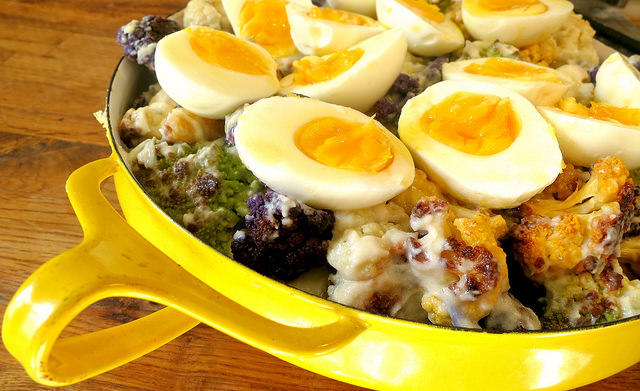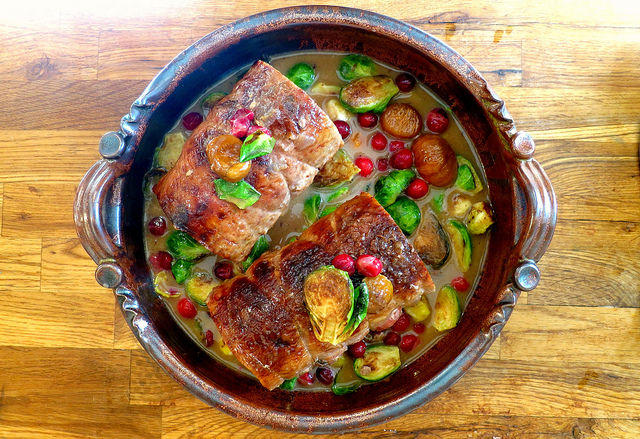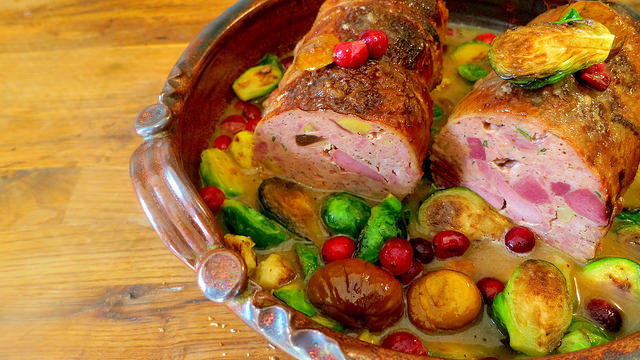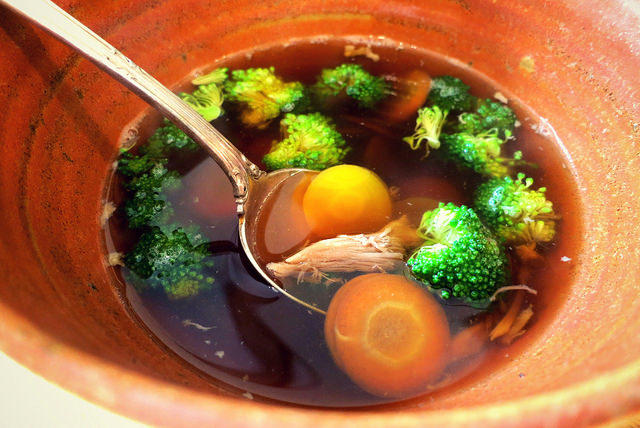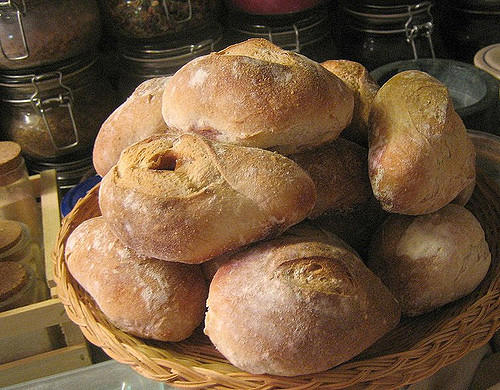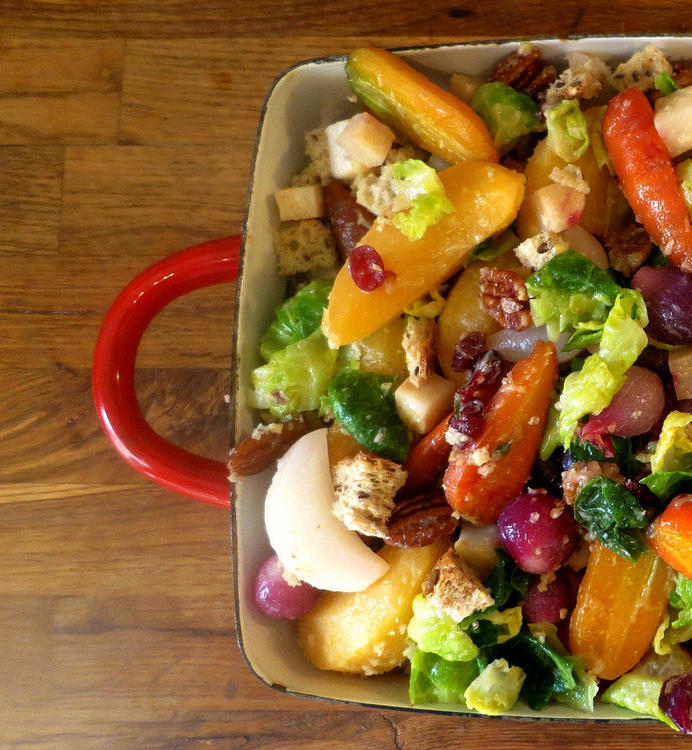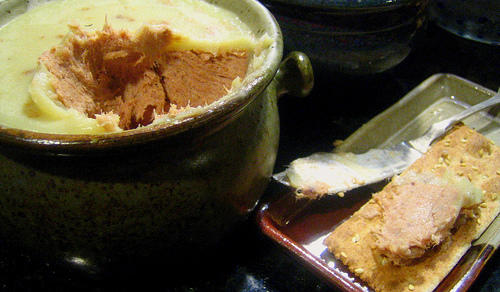-
Posts
270 -
Joined
-
Last visited
Content Type
Profiles
Forums
Store
Help Articles
Everything posted by Baron d'Apcher
-
Sous-vide (reduced oxygen) cooking can be dangerous if the product inside is not cooked for sufficient time/temp to pasteurize/kill most pathogens and/or if chilled improperly pathogens can multiply and they are not good to have in your body. SV safety is severely overlooked and underrated. Douglas Baldwin explains the safety issues and consequences of improper cooling very well.
-
Fine. But the link you provided was from Australia. Lamb gestation is 5 months and it takes at least 6, even 9 months for a lamb to reach market weight and the ones in the OP are at least 135lb hot weight which is huge and would definitely be graded 5. A dressed 6-8 week lamb will weigh no more than a suckling pig and the price will be prohibitive (baby vegetables vs full grown). Sheep can breed throughout the year, but not every breed does and the World Famous Welsh lamb that is available all year round might be breed artificially. Tomatoes are available all year round, but they still have a natural season. Wherever and whenever the OP's lamb were bred/born, they are at the fattiest end of the spectrum and I would not be comfortable selling them.
-
I should have specified that above the equator, most sheep naturally breed in the fall (October-November) and give birth in the spring (April-May). Below the equator it is likely the opposite. There is also a lot of artificial insemination in the US and Australia/NZ.
-
It looks like the huge Suffolk/Rambouillet breeds raised out in the Western US. They represent the far end of the spectrum for fat cover and such fatty animals might not be an efficient use of grain. The craving of fat is subjective, and I much prefer leaner beef. To each their own. Objectively however, lamb are born in the spring but slaughtered in the fall/winter, generally before they reach a year in age or else they must be labeled as mutton
-
That is not a healthy animal. Those are unnecessarily fatty breasts from an unnecessarily crap/grain fattened animal. Lamb fat is not a flavor that most people crave. Unless you are into making soap or candles, I would not recommend buying those ever again. I work on a farm where we raise and butcher lamb and have only seen anything barely close to that fatty from 5yr+ rams (mutton). Salt is flavor too, but within reason and marbled is much different than fatty.
-
If the rib-eyes have the deckle, that might explain the less-than tender chew.
-
Per the weight of the cleaned gizzards (remove the thick inner keratin lining): 2% salt 1% sugar .25% #1 cure Whole spices, herbs, garlic. So, for 1000g of gizzards: 20g salt 10g sugar 3g #1 cure Cure for 48 hrs. Put the gizzards in a pot, cover with cold water and bring to a boil. Strain through a colander and rinse, keep the spices and such. Cover with fat (poultry fat, lard, tallow or oil) and bring to a simmer. Cook in a 225F oven with a parchment cover for 3-4 hours or until tender. Cool in the fat, store in the fat refrigerated. If you don't have fat, cover the blanched gizzards with water and add a pinch of salt. Cook in the same manner.
-
Corned/confit gizzards are absolutely delicious, provided they are properly cured, cleaned and cooked tender - like rosy meat jellybeans. If not, they are chewy, brown and unappetizing. I use them in soups, salads, pastas, pâtés, ragouts, stews and virtually anything that beckons for a savory garnish. We even warm them up and snack on them at home with cocktails, pickes and nuts. Gizzards in a salad with a poached egg and dressing made with the goose fat is quite delectable.
-
That is curious since the hide can be removed so easily, tanned and used/sold for another purpose. Do they scald them to remove the wool or is the customer expected to dispatch the intact hide? I have seen wild venison and boar sold in Europe with hides intact, but they are aged with the hides, which have little secondary value.
-
For lamb, absolutely. The shank and neck muscles are lined with silver skin. Even the intramuscular silver skin in beef shank muscles gets tender after cooking. The fascia between the rib cage and deckle and outside the flank on lamb will get soft, however it will not dissolve. Above 160°F collagen will break down and melt nicely. *Aside from fish and poultry/fowl, the only common animals that will have skin after slaughter are pigs.
-
When sheep are slaughtered the hides (skin) is removed. Connective tissues and silver skin will melt easily above 170F. Cartilage is best removes as is thicker white layers (fascia), neither of which are delectable, even after cooking. Soft fat can melt, hard fat less so. Depends on whether or not you crave lamb the flavor of lamb fat (depends on the size and breed of the lamb too). I prefer to cook "stew meat" in the conventional, analog simmer/braise method. It allows you to prod and poke and test for flavor and doneness. Stewing cuts cooked at 133F will take an eternity to soften the collagen, and you won't have a sauce thickened by the gelatin.
-
The meaty bones may very well be delicious, but dogs might not have the temperament to chew them delicately. A friend of mine was house-sitting for a couple years ago and the duties included taking care of the dog -a mild mannered pug. A friend of his stopped by with some BBQ pork ribs to share with friend #1. Friend #2 wanted to give the finished pork bones to the dog but friend #1 protested, suggesting that heat makes bones brittle and cooked bones could choke the dog. Friend #2, in an effort to disprove the brittle bone lore, defiantly gave the bones to the dog. Within an hour, the dog choked on the bones and died.
-
Dogs don't mind freezer burn. It might not be worth testing the threshold of brittle splintering bones on the pooch. Any heat makes bones brittle.
-
Not sure when practice of pulling turkey tendons stopped, but old timer butchers have told me that prior to Big Ag, when animals were still being slaughtered in Hell's Kitchen in NYC, every turkey had their tendon's pulled. The idea of a turkey leg with the plastic-like tendons in the drumstick was unimaginable as they are as unpleasant to navigate as they are inedible. Consequently, unless I can get the bird with the feet still attached (from which I can yank the tendons with pliers) I refuse to cook a whole bird. Invariably, I debone and stuff the legs.
-
Smoked turkey consommé Turkey Rillettes Cauliflower Polonaise Turkey Leg Ballotine with chestnuts, Brussels sprouts and cranberries. Pan Coudon (bread with candied quince inside) Glazed root vegetables with dried cranberries, sourdough, walnuts and vinegar
- 120 replies
-
- 12
-

-
Try slicing the lardo very thinly so that it is transparent (flatten it between parchment paper with a rolling pin if need be) and leave it out a room temp for a bit until it is soft and flimsy. It should melt better.
-
"Curly endive" (Cichorium endivia). It's what most in the US call chicory and is more or less unremarkable. Like an unruly head of frisée. Escarole has wider, flatter leaves. Puntarella is very different.
-
I work (and live next to) a 35 acre farm on the North Fork of Long Island (NY). We raise Icelandic sheep in addition to pigs and chickens. The racks are always the most popular, which, like Paris Hilton and Zsa Zsa Gabor’s celebrity baffles me. The subtle variations between sub-primal muscles of the leg are nothing short of delicious when treated well. Below, from left to right: boneless neck, boneless shoulder "pumpkin", shank, shoulder chops, rack, breast/ribs, boneless saddle, top sirloin, knuckle, outside round, top round, shank. For those with more time and mouths to feed, I recommend the lamb pumpkins which are boneless shoulders (no shank) filled with merguez sausage (all lamb), bound with pancetta and wrapped in caul fat. They beckon crock pots or slow braise situations. Then there are the saddles which I de-bone and tie up. The loin, tenderloin, skirt and what would be the butt flap on a steer. The sinew, membranes and fat is judiciously removed, seasoned with ground juniper, rosemary and black pepper and rolled up. They roast well in cast iron pans or rotated slowly on the grill as on a rotisserie. And with trimmings I make winter crepinettes with lamb, bread crumb, Pecorino, milk, Meyer lemon and oregano. Wrapped in caul fat from the pigs. There are indeed far more options beyond the leg, rack and shanks. Makes one wonder where the rest often goes.
-
While it appears marbled, it is a tough cut. In France they colloquially call it "the sole", as in the sole of a shoe, given how not tender it is and they generally grind it. Pot roast or coat in mustard, slooooowly roast to medium rare and slice thin like roast beef.
-
It is possible that the translation from French to English is erroneous or that some subtleties of culinary terms have been overlooked. Boiling bones (blanching) that have been soaked in ice water overnight (to draw out any blood) will extract many of the impurities and fat. Rinse them well and simmer at 170F and the stock will be very clear.
-
The drumsticks of pheasants have very hard, unpleasant plastic-like tendons, much like those of a turkey. Best to remove them.
-

What's the Appeal of Cooking Sous Vide?
Baron d'Apcher replied to a topic in Food Traditions & Culture
BBQ being an exception I suppose. As well as pizzas, bread and other items borne from the hotbox. -

What's the Appeal of Cooking Sous Vide?
Baron d'Apcher replied to a topic in Food Traditions & Culture
Perhaps, but the product itself may not be consistent to begin with. Any vegetable/protein is sure to vary from one to another by virtue of season/location/manner in which it was raised,etc... SV has its merits (hams, galantines, large roasts), but it is difficult to check, poke, taste, probe or baste what is inside the bag and any applications that run on for 2 days take some of the joy out of analog cooking With a boneless leg of lamb, sure. Shanks not so much, less so when I don’t get any sauce. I simmer (low, controlled heat) stovetop often (shanks/pig head), with a thermometer and the variance of a few degrees is negligible over 5-6 hours. I'd be remiss if I relied on numbers for doneness/tenderness rather than tangible touching. Hearts & tongues I’ll gladly SV since the sizes are generally similar, don’t have the sinew/tendons of shanks, don't have any collagen for aspic and I dice them up anyway. I get satisfaction and joy from the entire process of a traditional braise; the aromas that draft from the oven, rotating them so they brown evenly, testing for doneness, playing with the temperature, building a sauce and being pleased with the results. It is validation and the sum of attention, senses, discipline and skill. I don’t get that from SV. The end product of SV may be close to subjective perfection, but the journey isn’t scenic and analog nuances aren’t a bad thing, like in live music, hand-blown glasses and a craftsman’s woodwork. What bothers me to no end is that the bags end up in a landfill. If someone can develop biodegradable no-cook vacuum bags and/or reusable bags, they'd do humanity a favor. -
Steer, not cow, unless it was a dairy cow. Regardless, lactic acid buildup in steers is likely lower as a result of stress but will make the meat tough rather than mushy. I am confident that any and all mushiness comes from too low of a cooking temperature; this occurs with SV rabbit in my experience. More than anything, the stress on a steer will result in darker, burgundy colored meat (feverish or dark cutter) which doesn't affect the flavor exactly (flavor being a component, but not the same thing as texture) but is an indicator of quality of slaughter and consumers should not accept paying premium for meat that was not treated properly between life and death. I saw a dark cutter arrive while apprenticing at Hugo Desnoyer in Paris and they immediately called the farmer and processor to halt any further slaughter until the process was remedied as their customers rely on Hugo's exceedingly high soup-to-nut standard of quality (animal breed, raising, slaughter, aging and butchery) and happily pay accordingly.
-
Balderdash. The round is severely overlooked and undervalued in the US, probably because most of the beef is commodity crap and it is very difficult to find any of the worthwhile cuts served in Europe (i.e. France) which has a formidable history of resourceful and disciplined butchery, as opposed to cutting just about everything on a band-saw and grinding the rest here. To wit, from a dry-aged carcass with decent marbling: Top sirloin: very flavorful if properly denuded. Top round: roast beef Culotte (top sirloin cap): Delicious Spider meat (gracilis, from the inside of the aitch bone, highly prized across the pond): Excellent flavor and texture Adductor (more tender part of the top round):decent for roasting, given the price. Pear (pectinus, attached to the adductor, very tender, given the price) Top round cap (attached to the pectinus); London broil, similar to skirt Bottom round/knuckle: if properly denuded it is a flavorful cut without any connective tissue or sinew. Shank: long simmers appropriate for pho and the like Marrow bones Outside round: much better to grind that than the more marketable chuck Eye of round: best for bresaola Bovine myology



